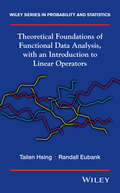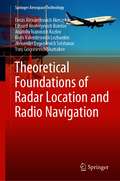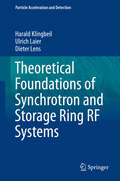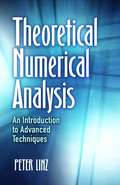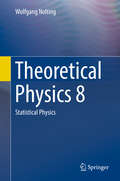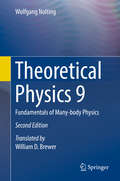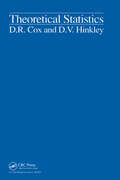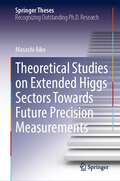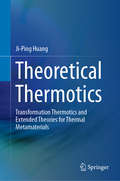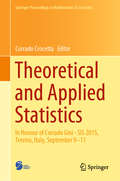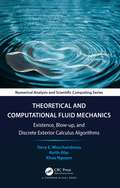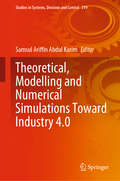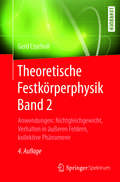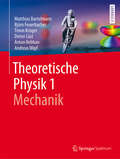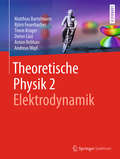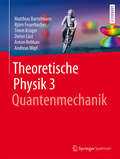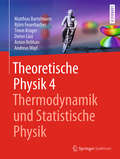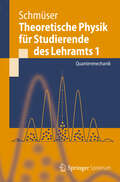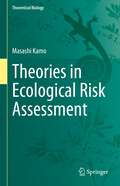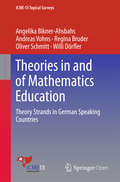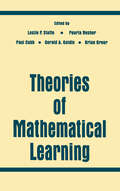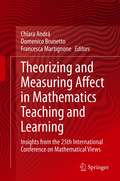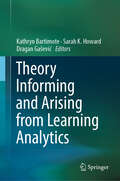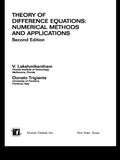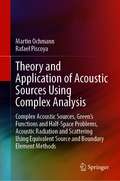- Table View
- List View
Theoretical Foundations of Functional Data Analysis, with an Introduction to Linear Operators (Wiley Series in Probability and Statistics #997)
by Tailen Hsing Randall EubankTheoretical Foundations of Functional Data Analysis, with an Introduction to Linear Operators provides a uniquely broad compendium of the key mathematical concepts and results that are relevant for the theoretical development of functional data analysis (FDA).The self–contained treatment of selected topics of functional analysis and operator theory includes reproducing kernel Hilbert spaces, singular value decomposition of compact operators on Hilbert spaces and perturbation theory for both self–adjoint and non self–adjoint operators. The probabilistic foundation for FDA is described from the perspective of random elements in Hilbert spaces as well as from the viewpoint of continuous time stochastic processes. Nonparametric estimation approaches including kernel and regularized smoothing are also introduced. These tools are then used to investigate the properties of estimators for the mean element, covariance operators, principal components, regression function and canonical correlations. A general treatment of canonical correlations in Hilbert spaces naturally leads to FDA formulations of factor analysis, regression, MANOVA and discriminant analysis.This book will provide a valuable reference for statisticians and other researchers interested in developing or understanding the mathematical aspects of FDA. It is also suitable for a graduate level special topics course.
Theoretical Foundations of Radar Location and Radio Navigation (Springer Aerospace Technology)
by Yury Grigorievich Shatrakov Denis Alexandrovich Akmaykin Eduard Anatolyevich Bolelov Anatoliy Ivanovich Kozlov Boris Valentinovich Lezhankin Alexander Evgenievich SvistunovThe book represents a study guide reciting theoretical basics of radar location and radio navigation systems of air and sea transport. This is the distinctive feature of this study guide.The study guide states the principal physics of radar location and radio navigation, main measuring methods of proper and relative movement parameters of an object, tactical and technical characteristics of radar location and radio navigation systems, including examining issues on radiofrequency signals detection and its parameters estimation against background and interference of different type, filtering, combined detection and rating of signals, signals resolution and classification. The structural and functioning principles of the current and advanced radar location and radio navigation systems of air and sea transport are represented in the study guide with an adequate completeness. The study guide features the result of years long lecturing on radar location and radio navigation theoretical courses at the Moscow State Technical University of Civil Aviation and G.I.Nevelskiy Maritime State Technical Academy. The study guide is designated for students of radio-engineering specialties in area of air and sea transport. The study guide can be useful for radio engineers working in the field of air and maritime transport, and for graduate students and academic researchers as well.
Theoretical Foundations of Synchrotron and Storage Ring RF Systems (Particle Acceleration and Detection)
by Harald Klingbeil Ulrich Laier Dieter LensThis is an open access book.This course-tested text is an ideal starting point for engineers and physicists entering the field of particle accelerators. The fundamentals are comprehensively introduced, derivations of essential results are provided and a consistent notation style used throughout the book allows readers to quickly familiarize themselves with the field, providing a solid theoretical basis for further studies.Emphasis is placed on the essential features of the longitudinal motion of charged particle beams, together with the corresponding RF generation and power amplification devices for synchrotron and storage ring systems. In particular, electrical engineering aspects such as closed-loop control of system components are discussed.The book also offers a valuable resource for graduate students in physics, electronics engineering, or mathematics looking for an introductory and self-contained text on accelerator physics.
Theoretical Numerical Analysis: An Introduction to Advanced Techniques (Dover Books on Mathematics)
by Peter LinzThis concise text introduces numerical analysis as a practical, problem-solving discipline. The three-part presentation begins with the fundamentals of functional analysis and approximation theory. Part II outlines the major results of theoretical numerical analysis, reviewing product integration, approximate expansion methods, the minimization of functions, and related topics. Part III considers specific subjects that illustrate the power and usefulness of theoretical analysis.Ideal as a text for a one-year graduate course, the book also offers engineers and scientists experienced in numerical computing a simple introduction to the major ideas of modern numerical analysis. Some practical experience with computational mathematics and the ability to relate this experience to new concepts is assumed. Otherwise, no background beyond advanced calculus is presupposed. Moreover, the ideas of functional analysis used throughout the text are introduced and developed only to the extent they are needed.
Theoretical Physics 8: Statistical Physics
by Wolfgang NoltingDer Grundkurs Theoretische Physik deckt in 7 Bänden alle für das Diplom und für Bachelor/Master-Studiengänge maßgeblichen Gebiete ab. Jeder Band vermittelt das im jeweiligen Semester notwendige theoretisch-physikalische Rüstzeug. Übungsaufgaben mit ausführlichen Lösungen dienen der Vertiefung des Stoffs. Der 6. Band zur Statistischen Physik wurde für die Neuauflage grundlegend überarbeitet und um aktuelle Entwicklungen ergänzt. Durch die zweifarbige Gestaltung ist der Stoff jetzt noch übersichtlicher gegliedert.
Theoretical Physics 9: Fundamentals of Many-body Physics
by Wolfgang NoltingThis textbook addresses the special physics of many-particle systems, especially those dominated by correlation effects. It develops modern methods to treat such systems and demonstrates their application through numerous appropriate exercises, mainly from the field of solid state physics. The book is written in a tutorial style appropriate for those who want to learn many-body theory and eventually to use this to do research work in this field. The exercises, together with full solutions for evaluating one's performance, help to deepen understanding of the main aspects of many-particle systems.This revised second edition presents new sections on the finite-temperature Matsubara formalism, in particular with respect to Dyson equation, the Hartree-Fock approximation, second order perturbation theory, spin density waves, Hubbard model, Jellium model, quasi particles, Fermi liquids and multi particle Matsubara functions.Completing the outstanding Theoretical Physics series, this book will be a valuable resource for advanced students and researchers alike.
Theoretical Statistics
by D.R. Cox D.V. HinkleyA text that stresses the general concepts of the theory of statistics Theoretical Statistics provides a systematic statement of the theory of statistics, emphasizing general concepts rather than mathematical rigor. Chapters 1 through 3 provide an overview of statistics and discuss some of the basic philosophical ideas and problems behind statistica
Theoretical Studies on Extended Higgs Sectors Towards Future Precision Measurements (Springer Theses)
by Masashi AikoThis book investigates the physics of the discovered Higgs boson and additional Higgs bosons in the extended Higgs models which includes higher-order quantum corrections. While the 125 GeV Higgs boson was discovered, the structure of the Higgs sector is still a mystery. Since the Higgs sector determines the concrete realization of the Higgs mechanism, the study of its nature is one of the central interests in current and future high-energy physics. The book begins with a review of the standard model and the two-Higgs doublet model, which is one of the representatives of the extended Higgs models. Subsequently, we discuss the studies of the two-Higgs doublet model at the lowest order of perturbation. Following the lowest-order analysis, we study the higher-order electroweak corrections in Higgs physics. After reviewing the renormalization procedure and the higher-order corrections in the decays of the discovered Higgs boson, we discuss the higher-order corrections in the Higgs strahlung process from an electron-positron collision, the decays of the additional charged and CP-odd Higgs bosons in the two-Higgs doublet model. From the series of these studies, it is found that the nature of the Higgs sector can be widely investigated by future collider experiments.
Theoretical Thermotics: Transformation Thermotics and Extended Theories for Thermal Metamaterials
by Ji-Ping HuangThis book focuses on theoretical thermotics, the theory of transformation thermotics and its extended theories for the active control of macroscopic thermal phenomena of artificial systems, which is in sharp contrast to classical thermodynamics comprising the four thermodynamic laws for the passive description of macroscopic thermal phenomena of natural systems. The book covers the basic concepts and mathematical methods, which are necessary to understand thermal problems extensively investigated in physics, but also in other disciplines of engineering and materials. The analyses rely on models solved by analytical techniques accompanied with computer simulations and laboratory experiments. This book serves both as a reference work for senior researchers and a study text for zero beginners.
Theoretical and Applied Statistics: In Honour Of Corrado Gini - Sis 2015, Treviso, Italy, September 9-11 (Springer Proceedings in Mathematics & Statistics #274)
by Corrado CrocettaThis book is devoted to Corrado Gini, father of the Italian statistical school. It celebrates the 50th anniversary of his death by bearing witness to the continuing extraordinary scientific relevance of his interdisciplinary interests. The book comprises a selection of the papers presented at the conference of the Italian Statistical Society, Statistics and Demography – the Legacy of Corrado Gini, held in Treviso in September 2015. The work covers many topics linked to Gini’s scientific legacy, ranging from the theory of statistical inference to multivariate statistical analysis, demography and sociology. In this volume, readers will find many interesting contributions on entropy measures, permutation procedures for the heterogeneity test, robust estimation of skew-normal parameters, S-weighted estimator, measures of multidimensional performance using Gini’s delta, small-sample confidence intervals for Gini’s gamma index, Bayesian estimation of the Gini-Simpson index, spatial residential patterns of selected foreign groups, minority segregation processes, dynamic time warping to study cruise tourism, and financial stress spill over. This book will appeal to all statisticians, demographers, economists, and sociologists interested in the field.
Theoretical and Computational Fluid Mechanics: Existence, Blow-up, and Discrete Exterior Calculus Algorithms (Chapman & Hall/CRC Numerical Analysis and Scientific Computing Series)
by Khoa Nguyen Terry E. Moschandreou Keith AfasTheoretical and Computational Fluid Mechanics: Existence, Blow-up, and Discrete Exterior Calculus Algorithms centralizes the main and current topics in theoretical and applied fluid dynamics at the intersection of a mathematical and non-mathematical environment. The book is accessible to anyone with a basic level of understanding of fluid dynamics and yet still engaging for those of a deeper understanding.The book is aimed at theorists and applied mathematicians from a wide range of scientific fields, including the social, health, and physical sciences. It provides a step-by-step guide to the construction of solutions of both elementary and open problems of viscous and non-viscous models, and for the applications of such models for the functional analysis and real analysis of data. Features Offers a self-contained treatment that does not require a previous background in fluid dynamics. Suitable as a reference text for graduate students, researchers, and professionals, and could easily be used as a teaching resource. Provides various examples using Maple, Mathematica, and to a lesser extent Matlab programming languages.
Theoretical, Modelling and Numerical Simulations Toward Industry 4.0 (Studies in Systems, Decision and Control #319)
by Samsul Ariffin Abdul KarimThis book presents theoretical modeling and numerical simulations applied to drive several applications towards Industrial Revolution 4.0 (IR 4.0). The topics discussed range from theoretical parts to extensive simulations involving many efficient algorithms as well as various statistical techniques. This book is suitable for postgraduate students, researchers as well as other scientists who are working in mathematics, statistics and numerical modeling and simulation.
Theoretische Festkörperphysik Band 2: Anwendungen: Nichtgleichgewicht, Verhalten in äußeren Feldern, kollektive Phänomene
by Gerd CzychollDer vorliegende Band 2 deckt fortgeschrittene Themen der theoretischen Festkörperphysik ab und knüpft damit direkt an die Grundlagen an. Dabei werden Festkörper in äußeren Feldern bzw. allgemeiner im Nichtgleichgewicht und Abweichungen von der idealen 3-dimensionalen Kristallstruktur (Oberflächen, Störstellen, niederdimensionale Strukturen, Quantenpunkte, etc.) behandelt. Die Betrachtung von kollektiven Phänomene wie Supraleitung und Magnetismus runden die Darstellung ab. Beim Leser werden die Inhalte von Band 1 (Elektronen und Phononen in idealen Kristallen, Bloch-Theorem, Besetzungszahldarstellung bzw. 2. Quantisierung, Elektron-Elektron- und Elektron-Phonon-Wechselwirkung) vorausgesetzt sowie die Grundkenntnisse in allgemeiner Theoretischer Physik (Mechanik, Elektrodynamik, Quantenmechanik und Statistische Physik), wie sie in der Regel nach einem Bachelor-Studium der Physik vorhanden sind. Band 2 eignet sich also hervorragend für Studierende im Master-Studiengang Physik, die sich auf (experimentelle oder theoretische) Festkörperphysik spezialisieren wollen. Das Ansprechen von aktuellen Themen (z.B. Kondo-Effekt, fraktioneller Quanten-Hall-Effekt, 2-dimensionale Kristalle wie Graphen, Riesen-Magnetowiderstands-Effekt u.a.) bietet einen optimalen Übergang zur modernen Forschung.Die Neuauflage wurde komplett überarbeitet, um zahlreiche Übungsaufgaben erweitert und vorhandene neu konzipiert, wobei die zugehörigen Lösungen nun mit ins Buch aufgenommen sind.
Theoretische Physik 1 | Mechanik: Mechanik
by Matthias Bartelmann Timm Krüger Björn Feuerbacher Andreas Wipf Dieter Lüst Anton RebhanDas beliebte Buch Theoretische Physik wird jetzt erstmalig in korrigierter und ergänzter Form in Einzelbänden angeboten. Das ermöglicht den Studierenden, die handlichen Bände zum Lernen, Aufgabenlösen und zum schnellen Nachschlagen leichter mitnehmen und nutzen zu können. Gleichzeitig wird die gesamte theoretische Physik des Bachelorstudiums (und darüber hinaus) in den vier Bänden aufeinander abgestimmt präsentiert. Das vorliegende Buch ist der erste Teil der vierbändigen Reihe und deckt den Lehrstoff der Bachelorvorlesung zur Theoretischen Mechanik großer Universitäten in Deutschland, Österreich und der Schweiz möglichst umfassend ab.Die besondere Stärke dieser Reihe liegt darin, den Leser mit einer Vielzahl von didaktischen Elementen beim Lernen zu unterstützen:-Alle Kapitel werden mit grundsätzlichen Fragen eingeleitet-Wichtige Aussagen, Formeln und Definitionen sind übersichtlich hervorgehoben-Beispiele regen zum Aktivwerden an-Selbstfragen helfen dem Leser, den behandelten Stoff zu reflektieren-„So geht’s weiter“-Abschnitte, beispielsweise über den Lense-Thirring-Effekt oder Determinismus und Chaos ermöglichen einen Blick über den Tellerrand und geben Einblicke in aktuelle Forschung-Anhand ausführlich gelöster Aufgaben kann das Gelernte überprüft und gefestigt werden-Mathematische Boxen sind zum schnellen Nachschlagen herausgehoben -Alle Bände sind durchgehend vierfarbig und mit übersichtlichen Grafiken gestaltet.Die Autoren haben ihre langjährige und vielfach hervorragend bewertete Lehrerfahrung in das Werk einfließen lassen. Darüber hinaus gelingt es ihnen, die Zusammenhänge in der Theoretischen Physik auch bandübergreifend klar werden zu lassen.Der InhaltDie Newton’schen Axiome – Koordinationstransformationen und beschleunigte Bezugssysteme – Systeme von Punktmassen – Starre Körper – Lagrange-Formalismus und Variationsrechnung – Schwingungen – Hamilton-Formalismus – Kontinuumsmechanik – Spezielle Relativitätstheorie – Relativistische Mechanik
Theoretische Physik 2 | Elektrodynamik
by Matthias Bartelmann Timm Krüger Björn Feuerbacher Andreas Wipf Dieter Lüst Anton RebhanDas beliebte Buch Theoretische Physik wird jetzt erstmalig in korrigierter und ergänzter Form in Einzelbänden angeboten. Das ermöglicht den Studierenden, die handlichen Bände zum Lernen, Aufgabenlösen und zum schnellen Nachschlagen leichter mitnehmen und nutzen zu können. Gleichzeitig wird die gesamte theoretische Physik des Bachelorstudiums (und darüber hinaus) in den vier Bänden aufeinander abgestimmt präsentiert. Das vorliegende Buch ist der zweite Teil der vierbändigen Reihe und deckt den Lehrstoff der Bachelorvorlesung zur Elektrodynamik großer Universitäten in Deutschland, Österreich und der Schweiz möglichst umfassend ab. Die besondere Stärke dieser Reihe liegt darin, den Leser mit einer Vielzahl von didaktischen Elementen beim Lernen zu unterstützen: -Alle Kapitel werden mit grundsätzlichen Fragen eingeleitet -Wichtige Aussagen, Formeln und Definitionen sind übersichtlich hervorgehoben -Beispiele regen zum Aktivwerden an -Selbstfragen helfen dem Leser, den behandelten Stoff zu reflektieren -„So geht’s weiter“-Abschnitte, beispielsweise über nichtlineare Elektrodynamik und effektive Feldtheorien ermöglichen einen Blick über den Tellerrand und geben Einblicke in aktuelle Forschung -Anhand ausführlich gelöster Aufgaben kann das Gelernte überprüft und gefestigt werden -Mathematische Boxen sind zum schnellen Nachschlagen herausgehoben -Alle Bände sind durchgehend vierfarbig und mit übersichtlichen Grafiken gestaltet. Die Autoren haben ihre langjährige und vielfach hervorragend bewertete Lehrerfahrung in das Werk einfließen lassen. Darüber hinaus gelingt es ihnen, die Zusammenhänge in der Theoretischen Physik auch bandübergreifend klar werden zu lassen. Der Inhalt Die Maxwell-Gleichungen – Elektrostatik – Vollständige Funktionssysteme: Fourier-Transformation und Multipolentwicklung – Elektrische Felder in Materie – Magnetismus und elektrische Ströme – Ausbreitung elektromagnetischer Wellen – Optik – Relativistische Formulierung der Elektrodynamik – Abstrahlung elektromagnetischer Wellen – Lagrange- und Hamilton-Formalismus in der Elektrodynamik
Theoretische Physik 3 | Quantenmechanik: Quantenmechanik 1
by Matthias Bartelmann Timm Krüger Björn Feuerbacher Andreas Wipf Dieter Lüst Anton RebhanDas beliebte Buch Theoretische Physik wird jetzt erstmalig in korrigierter und ergänzter Form in Einzelbänden angeboten. Das ermöglicht den Studierenden, die handlichen Bände zum Lernen, Aufgabenlösen und zum schnellen Nachschlagen leichter mitnehmen und nutzen zu können. Gleichzeitig wird die gesamte theoretische Physik des Bachelorstudiums (und darüber hinaus) in den vier Bänden aufeinander abgestimmt präsentiert. Das vorliegende Buch ist der dritte Teil der vierbändigen Reihe und deckt den Lehrstoff der Bachelorvorlesung zur Quantenmechanik großer Universitäten in Deutschland, Österreich und der Schweiz möglichst umfassend ab. Die besondere Stärke dieser Reihe liegt darin, den Leser mit einer Vielzahl von didaktischen Elementen beim Lernen zu unterstützen: -Alle Kapitel werden mit grundsätzlichen Fragen eingeleitet -Wichtige Aussagen, Formeln und Definitionen sind übersichtlich hervorgehoben -Beispiele regen zum Aktivwerden an -Selbstfragen helfen dem Leser, den behandelten Stoff zu reflektieren -„So geht’s weiter“-Abschnitte, beispielsweise über Supersymmetrie in der Quantenmechanik ermöglichen einen Blick über den Tellerrand und geben Einblicke in aktuelle Forschung -Anhand ausführlich gelöster Aufgaben kann das Gelernte überprüft und gefestigt werden -Mathematische Boxen sind zum schnellen Nachschlagen herausgehoben -Alle Bände sind durchgehend vierfarbig und mit übersichtlichen Grafiken gestaltet. Die Autoren haben ihre langjährige und vielfach hervorragend bewertete Lehrerfahrung in das Werk einfließen lassen. Darüber hinaus gelingt es ihnen, die Zusammenhänge in der Theoretischen Physik auch bandübergreifend klar werden zu lassen. Der Inhalt Die Entstehung der Quantenphysik – Wellenmechanik – Formalismus der Quantenmechanik – Observablen, Zustände und Unbestimmtheit – Zeitentwicklung und Bilder – Eindimensionale Quantensysteme – Symmetrien und Erhaltungssätze – Zentralkräfte, das Wasserstoffatom – Elektromagnetische Felder und der Spin – Störungstheorie und Virialsatz – Mehrteilchensysteme und weitere Näherungsmethoden – Streutheorie
Theoretische Physik 4 | Thermodynamik und Statistische Physik
by Matthias Bartelmann Timm Krüger Björn Feuerbacher Andreas Wipf Dieter Lüst Anton RebhanDas beliebte Buch Theoretische Physik wird jetzt erstmalig in korrigierter und ergänzter Form in Einzelbänden angeboten. Das ermöglicht den Studierenden, die handlichen Bände zum Lernen, Aufgabenlösen und zum schnellen Nachschlagen leichter mitnehmen und nutzen zu können. Gleichzeitig wird die gesamte theoretische Physik des Bachelorstudiums (und darüber hinaus) in den vier Bänden aufeinander abgestimmt präsentiert. Das vorliegende Buch ist der vierte Teil der vierbändigen Reihe und deckt den Lehrstoff der Bachelorvorlesung zur Thermodynamik und Statistischen Physik großer Universitäten in Deutschland, Österreich und der Schweiz möglichst umfassend ab. Die besondere Stärke dieser Reihe liegt darin, den Leser mit einer Vielzahl von didaktischen Elementen beim Lernen zu unterstützen: -Alle Kapitel werden mit grundsätzlichen Fragen eingeleitet -Wichtige Aussagen, Formeln und Definitionen sind übersichtlich hervorgehoben -Beispiele regen zum Aktivwerden an -Selbstfragen helfen dem Leser, den behandelten Stoff zu reflektieren -„So geht’s weiter“-Abschnitte, beispielsweise über das Curie-Weiss-Modell, Weiße Zwerge und Systeme außerhalb des Gleichgewichts ermöglichen einen Blick über den Tellerrand und geben Einblicke in aktuelle Forschung -Anhand ausführlich gelöster Aufgaben kann das Gelernte überprüft und gefestigt werden -Mathematische Boxen sind zum schnellen Nachschlagen herausgehoben -Alle Bände sind durchgehend vierfarbig und mit übersichtlichen Grafiken gestaltet. Die Autoren haben ihre langjährige und vielfach hervorragend bewertete Lehrerfahrung in das Werk einfließen lassen. Darüber hinaus gelingt es ihnen, die Zusammenhänge in der Theoretischen Physik auch bandübergreifend klar werden zu lassen. Der Inhalt Phänomenologische Begründung der Thermodynamik – Statistische Begründung der Thermodynamik – Einfache thermodynamische Anwendungen – Ensembles und Zustandssummen – Quantenstatistik
Theoretische Physik für Studierende des Lehramts 2
by Peter SchmüserDas zweibändige Lehrbuch vermittelt die Grundlagen der theoretischen Physik und berücksichtigt dabei besonders die Quantenmechanik, die spezielle Relativitätstheorie und die Elektrodynamik für den Unterricht an Gymnasien. Band 2 bietet eine systematische Einführung in die Elektrodynamik auf Basis der Maxwellschen Gleichungen sowie eine Einführung in die relativistische Mechanik. Der Stoff wird einfach und klar dargestellt, Abbildungen und didaktische Anmerkungen erleichtern den Zugang zur Theorie und geben Hinweise für die Vermittlung im Unterricht.
Theories in Ecological Risk Assessment (Theoretical Biology)
by Masashi KamoThis book introduces various mathematical models used in ecological risk assessment, primarily discussing models used in hazard assessment. The book aims to link ecology and conservation biology with risk assessments, bringing together the knowledge of ecotoxicology and ecology for effective risk assessment. The first part describes population-level assessment in ecological risk assessment. The chapters cover current methodologies for ecological risk assessment, individual-level assessment, population dynamics models for population-level assessment, case studies, mathematical models for population extinctions, the derivation of mean time to extinction (MTE) and their case studies. The second part of the book discusses the mathematical models involved in hazard assessments. It introduces the method of risk assessment using species sensitivity distributions (SSDs), hazard assessment of metals, chemical mixtures using the Michaelis-Menten equation, basic elements of statistics and related topics. Expected readers are risk assessors in governments and public sectors, students and young researchers interested in environmental science. The book is made accessible and easy to follow by beginners in mathematical biology and theoretical ecology.
Theories in and of Mathematics Education
by Angelika Bikner-Ahsbahs Andreas Vohns Regina Bruder Oliver Schmitt Willi DörflerThis survey provides an overview of German meta-discourse on theories and mathematics education as a scientific discipline, from the 1970s to the 1990s. Two theory strands are offered: a semiotic view related to Peirce and Wittgenstein (presented by Willibald Dorfler), and the theory of learning activity by Joachim Lompscher (presented by Regina Bruder and Oliver Schmitt). By networking the two theoretical approaches in a case study of learning fractions, it clarifies the nature of the two theories, how they can be related to inform practice and renew TME-issues for mathematics education as a scientific discipline. Hans-Georg Steiner initiated the first of five international conferences on Theories of Mathematics Education (TME) to advance the founding of mathematics education as a scientific discipline, and subsequently German researchers have continued to focus on TME topics but within various theory strands. "
Theories of Mathematical Learning: Constructivist And Interactionist Theories Of Mathematical Development
by Leslie P. Steffe Paul Cobb Brian Greer Pearla Nesher Gerald A. GoldinChemists, working with only mortars and pestles, could not get very far unless they had mathematical models to explain what was happening "inside" of their elements of experience -- an example of what could be termed mathematical learning. This volume contains the proceedings of Work Group 4: Theories of Mathematics, a subgroup of the Seventh International Congress on Mathematical Education held at Université Laval in Québec. Bringing together multiple perspectives on mathematical thinking, this volume presents elaborations on principles reflecting the progress made in the field over the past 20 years and represents starting points for understanding mathematical learning today. This volume will be of importance to educational researchers, math educators, graduate students of mathematical learning, and anyone interested in the enterprise of improving mathematical learning worldwide.
Theorizing and Measuring Affect in Mathematics Teaching and Learning: Insights from the 25th International Conference on Mathematical Views
by Chiara Andrà Domenico Brunetto Francesca MartignoneThis book presents a literature review of and a state-of-the-art glimpse into current research on affect-related aspects of teaching and learning in and beyond mathematics classrooms. Then, research presented at the MAVI 25 Conference, which took place in Intra (Italy) in June 2019, is grouped in thematic strands that capture cutting-edge issues related to affective components of learning and teaching mathematics. The concluding chapter summarises the main messages and sketches future directions for research on affect in mathematics education. The book is intended for researchers in mathematics education and especially graduate students and PhD candidates who are interested in emotions, attitudes, motivations, beliefs, needs and values in mathematics education.
Theory Informing and Arising from Learning Analytics
by Kathryn Bartimote Sarah K. Howard Dragan GaševićTheory Informing and Arising from Learning Analytics delves into the dynamic intersection of learning theory and educational data analysis within the field of Learning Analytics (LA). This groundbreaking book illuminates how theoretical insights can revolutionize data interpretation, reshape research methodologies, and expand the horizons of human learning and educational theory. Organized into three distinct sections, it offers a comprehensive introduction to the role of theory in LA, features contributions from leading scholars who apply diverse theoretical frameworks to their research, and explores cutting-edge topics where new theories are emerging. A standout feature is the inclusion of three “in conversation” chapters, where expert panels dive into the topics of ethics, self-regulated learning, and qualitative computation, enriched by accompanying podcasts that provide fresh, thought-provoking perspectives. This book is an invaluable resource for researchers, sparking debates on the evolving role of theory in LA and challenging conventional epistemological views. Published by Springer, it is an essential read for both aspiring and seasoned scholars eager to engage with the forefront of LA research.
Theory Of Difference Equations Numerical Methods And Applications: Numerical Methods And Applications
by V. Lakshmikantham V. Trigiante"Provides a clear and comprehensive overview of the fundamental theories, numerical methods, and iterative processes encountered in difference calculus. Explores classical problems such as orthological polynomials, the Euclidean algorithm, roots of polynomials, and well-conditioning."
Theory and Application of Acoustic Sources Using Complex Analysis: Complex Acoustic Sources, Green’s Functions and Half-Space Problems, Acoustic Radiation and Scattering Using Equivalent Source and Boundary Element Methods
by Martin Ochmann Rafael PiscoyaThis book highlights the mathematical and physical properties of acoustical sources with singularities located in the complex plane and presents the application of such special elements to solve acoustical radiation and scattering problems. Sources whose origin lies in the complex plane are also solutions of the wave equation but possess different radiating properties as their counterparts with real positions. Such mathematical constructions are known in the fields of optics and electrodynamics, but they are not common in acoustical research. The objective of the book is to introduce this concept to acousticians and motivate them to engage themselves in further research and application of complex sources. Such sources are particularly useful to formulate Green’s functions and related equivalent source and boundary element methods in half-spaces.
